Home »
The Peugeot Expert has one of the best towing capacity ratings in the medium van segment with an unbraked trailer towing capacity of 750kg and a braked trailer towing capacity of 2.5-tonnes or 2,500kg.
The Expert has a good towing capacity compared to other mid-sized vans which has improved over the years. The previous version of the Expert was limited to a 2000kg capacity but the new Expert van gets a much better 2,500kg.
Because of this the towing capacity of the Peugeot Expert is better than rivals but is still a lot less than a large van. If you really want to tow a lot then a pick-up truck is probably the best option or something bigger because the Ford Transit towing capacity is much greater than a medium van.
Incidentally, you can also compare the towing capacity of the medium-sized Ford Transt Custom towing capacity in our helpful guide.
How good the Expert is for towing depends on the engine you have because all Expert vans have the same towing capacity of 2.5-tonnes. Whether you have the Peugeot Expert 2.0 HDI or the 1.6 HDI the towing capacity is still 2500kg.
The Expert comes in 125hp and 145hp versions, so if you intend to pull a trailer at full weight you’re better off with a more powerful engine. That’s not to say the small one is a slouch, but the Expert 2.0 HDI has a better chance of doing the towing job more easily and with less fuss.
You need to consider the vehicles entire weight when finding the towing limit of a van.The gross combination weight (GCW) also referred to as the gross train weight (GTW) affects what you can pull and the Peugeot Expert van towing capacity.
The weight of the van, its payload (even the driver and passengers) as well as the weight of the trailer your towing all contribute to the GCW of the van.
The all important question then is, what is the gross combination weight of the Expert. Thankfully that is a simple answer as all the Expert van models have the same figure. Oh wait, there’s an exception – isn’t there always – the double cab variants have a slight difference.
Double cab variants of the Peugeot Expert have a gross combination weight (GCW) of 5.6-tonnes or 5600kg.
As the GVW is limited to 3100kg for the biggest versions of the Peugeot Expert, when you factor in the overall 2500kg max weight that is permitted of the trailer plus its payload, it means that it is impossible to exceed the GCW even if you have a full payload. Of course you need to not break the rules on the Peugeot Expert payload maximums, or else you’ll not only be in trouble for overloading the van but you’ll have an overweight van and trailer combination too.
So, that’s the general rule for GCW applied to the Expert but there’s a slight variation which goes back to the engine sizes. The Peugeot Expert 2.0 HDI towing capacity is greater the 1.5 HDI engine as it has a lower gross vehicle weight of 2830kg.
That means you’ll need to be aware of the overall Peugeot Expert payload so it’s best to check plates on the vehicle. These can usually be found either inside the door or under the bonnet of the van.
The Peugeot Expert van does not come with a towbar as standard. There is, however, an option for one to be added as a factory option.
The ball and hook tow bar option is available on the Expert for all models which gives you a 13-pin connector plug. It costs around £700 – which is quite punchy for a towbar connector on a van.
Let’s hope you haven’t broken down and that’s why you need to know how to tow the Peugeot Expert. In order to tow the Peugeot Expert van you’ll need to find the towing eye which is the circular loop you’ll attach a towing rope of bar to.
The towing eye location on the Peugeot Expert can be found under the front bumper. It’s to one side of the main chassis arm, so you need to go under the front of the van to look for it.
Once it’s hooked up you need to think about how the rope or bar will press against the bumper when you are towing – you don’t want to cause any unnecessary damage.
The Peugeot Expert panel van can tow 750kg with an unbraked trailer and 2500kg with a braked trailer
When it comes to medium-sized vans, the Stellantis-made Citroen Dispatch has one of the best towing capacity ratings in the sector.
The Citroen Dispatch towing capacity is up to 2.5-tonnes or 2,500kg which is the total towing capacity for a braked trailer on the latest van.
For towing an unbraked trailer the Citroen Dispatch has a towing capacity of up to 750kg.
The key question is:
The Citroen Dispatch panel van can tow 750kg with an unbraked trailer and 2500kg with a braked trailer.
There’s no doubt that the Dispatch towing capacity is better than many other mid-sized vans. The older versions limited to towing up to 2000kg, but the new Dispatch van can pull an even more impressive 2,500kg.
As a result, the towing capacity of the Citroen Dispatch is better than some of the competition. However, it is still well below the highest towing vans which are even greater on large vans. The towing capacity of a Sprinter van is even greater, comparable to the ratings of a pick-up truck.
Just how good the Dispatch is for towing will also depend on which model you decide to buy. That’s because all Dispatch vans have the same towing capacity of 2.5-tonnes. Irrespective of which engine you buy, the highest powered and the lowest horsepower versions all get the same towing rating.
There are both 125hp and 145hp versions to choose from, but of course towing a full trailer requires power, so our advice would be to opt for the Dispatch with the largest engine rating if you intended to make a habit out of towing something like a mini digger, fully loaded trailer or even a caravan with the Dispatch.
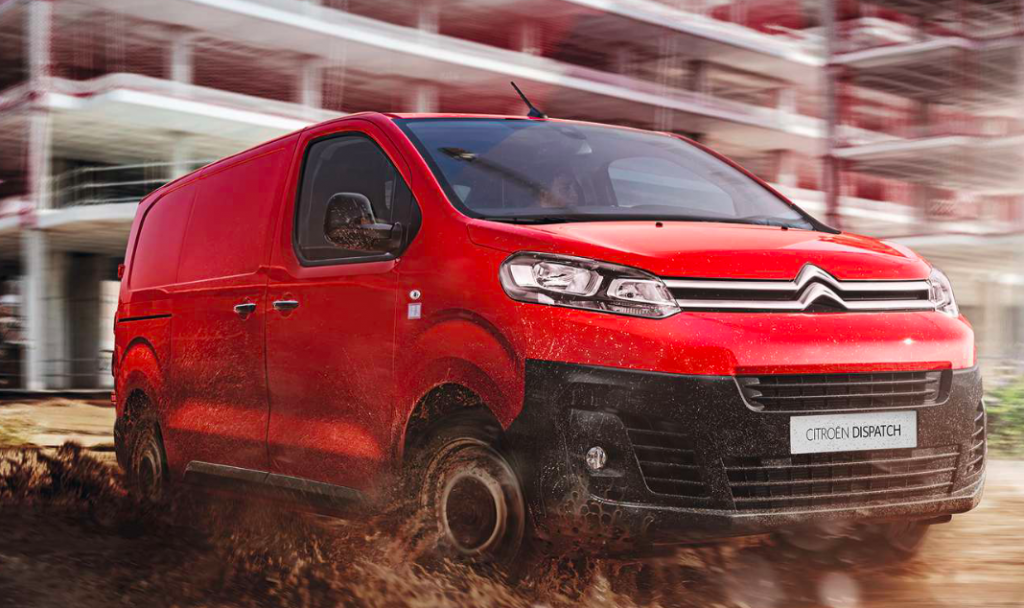
Unfortunately, there’s no catch-all solution to saying that the Dispatch can simply tow 2.5-tonnes. It’s not as simple as that because you need to consider the vehicles entire weight. That’s because the gross combination weight (GCW) or gross train weight (GTW) will have an impact on what you can pull with the Dispatch.
Essentially, the GCW or GTW is the weight of the van, plus any payload in the cargo area, and the weight of the trailer or whatever you are towing.
This is how you can determine the complete towing limit for the Citroen Dispatch and if it was an equation it would be: Kerbweight + Payload + Trailer Weight = GCW.
The gross combination weight of the Dispatch is a mercifully simple thing, that’s because all the models have the same figure, except for the double cab variants.
Double cab variants of the Citroen Dispatch have a gross combination weight (GCW) of 5.6-tonnes or 5600kg.
As the GVW (gross vehicle weight) – the weight of the van plus the maximum payload – is limited to 3100kg for the largest versions of the Citroen Dispatch, when you factor in the maximum 2500kg that is permitted for the weight of the trailer plus its payload, it means that it is impossible to exceed GCW (gross combination weight) even if you have a full payload.
That’s the general rule. Of course, there’s always an exception to the rule as that was the Citroen Dispatch 2.0 HDI towing capacity. So, if you have the 1.5-litre engine then be aware that it has a lower gross vehicle weight of 2830kg.
What that means is that you’ll just have to be more aware of the overall Citroen dispatch payload that you can have in the rear loadspace of the van.
As always, our advice is to check plates for the vehicle which can often be found either inside the door frames – most often on the passenger side – or under the bonnet of the van.
The Citroen Dispatch van does not come with a towbar as standard. There is, however, an option for one to be added as a factory option.
There’s a ball and hook tow bar option available on the Dispatch for all models which gives you a 13-pin connector plug to allow you to wire up the tow bar. It’s available (at the time of writing) for the princely £700 price tag for the Dispatch towbar.
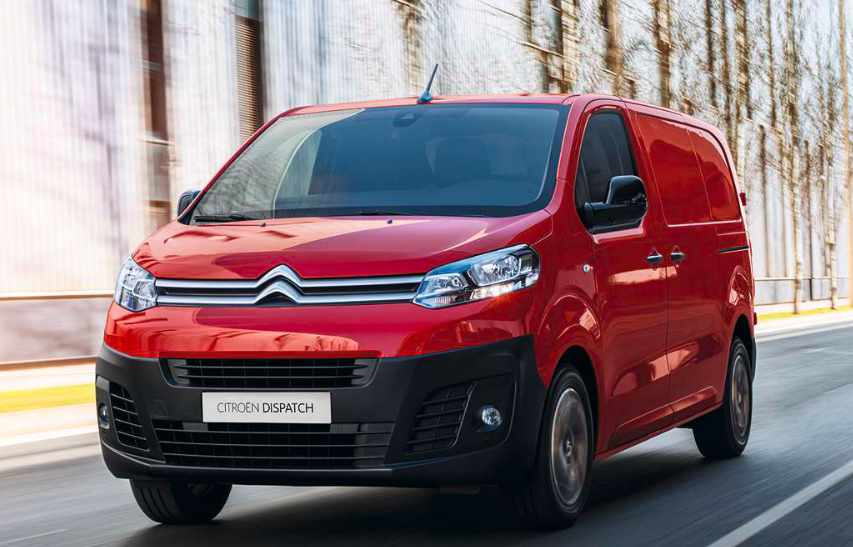
So, you want to know how to tow a Dispatch, well, you’ll need to find the van’s towing eye.
That’s the circular loop you’ll attach a towing rope of bar to. The towing eye location on the Dispatch can be found under the front bumper, off to the side of the main chassis arm. But you need to go under the front of the van in order to find the towing eye, and then you will also have to be considerate of the rope or bar pressing against the bumper itself when you are towing.
The Ram ProMaster is the North American version of the large Stellantis cargo van with a towing capacity to rival the largest of pick-up trucks.
You may think of it as just being a cargo van, but large vans are capable of towing a lot more than you might think. You can check out how much its rivals can tow with our guides to the other large vans where you'll find the Ford Transit towing capacity and the Mercedes-Benz Sprinter towing capacity.
This, though, is the ultimate guide to the Ram ProMaster towing capacity which as well as telling you how much a Ram ProMaster can tow, will also cover how to tow using a ProMaster cargo van.
This guide is applicable to the current generation of the US/North American Ram ProMaster cargo van, launched in 2008 after the Dodge Sprinter was dropped from the market.
Its essentially the only Ram van that has been on sale, and although the Dodge badge appears on the ProMaster, the cargo van is very different to any of the Dodge badged vans from the past.
The Ram ProMaster cargo van towing capacity depends on the size of the cargo van you have, but to make it simple for you, the ProMaster cargo van range has a capacity from 5100 lbs to 6910lbs for its maximum towing ability.
The total trailer weight rating of the Ram ProMaster depends on which GVWR version you have, the smaller ProMaster 1500 towing capacity is larger than that of its larger siblings the ProMaster 2500 and ProMaster 3500.
We'll break down the individual towing ratings for each of the Ram ProMaster GVWRs in the next sections.
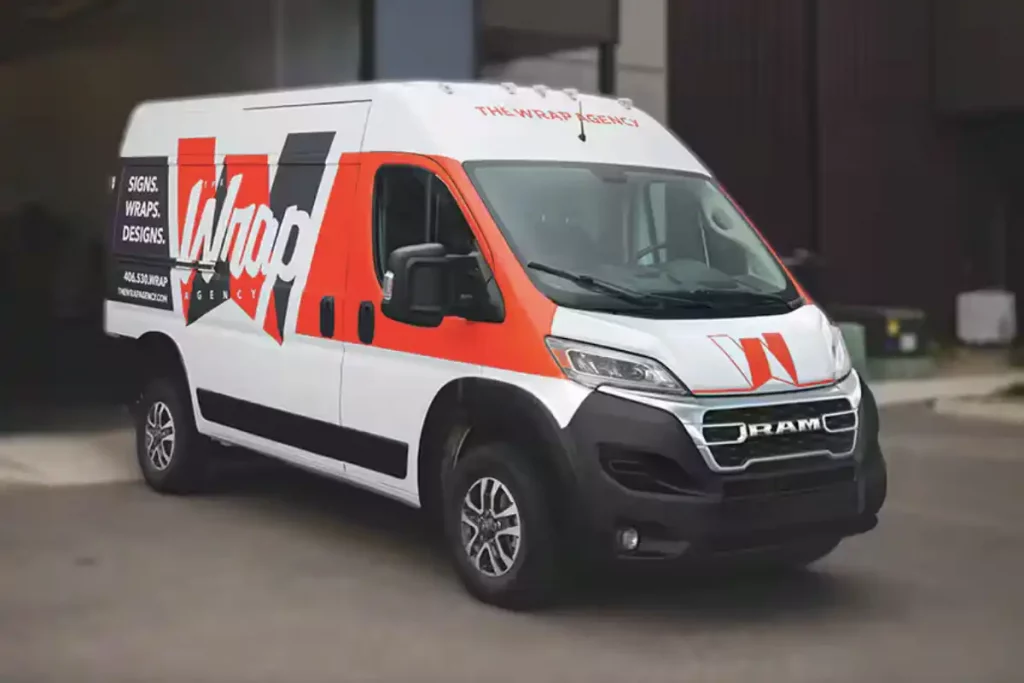
Although the Ram Promaster 1500 is the smallest cargo van in the line-up, it offers the best towing capacity. This is because the Ram vans are all rated to the same towing maximum but the amount they can tow is determined by their own kerbweight.
The smallest Ram 1500 ProMaster Cargo Low Roof with an 118-inch wheelbase is the smallest model in the range and therefore gets the largest towing capacity of 6,910lbs.
Increasing the wheelbase length from 118-inches to 136-inches adds more weight which reduces the max towing capacity to 6,800lbs. Similarly adding a high roof to the same 136-inch chassis drops the towing capacity another 100lbs to 6,700lbs.
| Ram ProMaster 1500 | Towing Capacity (Lbs) |
|---|---|
| RAM 1500 PROMASTER Cargo Low Roof 118" Wheelbase | 6910 |
| RAM 1500 PROMASTER Cargo Low Roof 136" Wheelbase | 6800 |
| RAM 1500 PROMASTER Cargo High Roof 136" Wheelbase | 6700 |
While the higher GVWR number for the Ram ProMaster improves payload, it doesn't have a positive affect on the towing capacity.
That means that the ProMaster 2500 has a very similar max towing ability to the smaller and larger models and is based purely on the wheelbase and therefore kerbweight of the cargo van.
The Ram Promaster 2500 with the largest maximum towing ability is the 136-inch low roof model which has a maxmimum towing capacity of 6,800lbs.
There's a longer wheelbase measuring 159-inches which reduced the towing capacity to 6,480 lbs which is the same whether it is a cargo van or a windowed van - both of which come with high roofs.
All Ram ProMaster 2500s have a GCWR of 12,000 pounds.
| Ram ProMaster 2500 | Towing Capacity (Lbs) |
|---|---|
| RAM 2500 PROMASTER Cargo Low Roof 136" Wheelbase | 6800 |
| RAM 2500 PROMASTER Cargo High Roof 136" Wheelbase | 6700 |
| RAM 2500 PROMASTER Cargo High Roof 159" Wheelbase | 6480 |
| RAM 2500 PROMASTER Window High Roof 159" Wheelbase | 6480 |
You might be thinking that as the biggest van in the range the Ram ProMaster 3500 towing capacity would also be the largest, but that's not the case.
The maximum towing capacity of the Ram ProMaster 3500 is 6,700 for the low roof 136-inch wheelbase model.
All ProMaster 3500 chassis cabs have a towing capacity of 5,100 lbs.
| Ram ProMaster 3500 | Towing Capacity (Lbs) |
|---|---|
| RAM 3500 PROMASTER Chassis Cab Low Roof 136" Wheelbase | 5100 |
| RAM 3500 PROMASTER Chassis Cab Low Roof 159" Wheelbase | 5100 |
| RAM 3500 PROMASTER Chassis Cab Low Roof 159" Wheelbase Extended | 5100 |
| RAM 3500 PROMASTER Cargo Low Roof 136" Wheelbase | 6,700 |
| RAM 3500 PROMASTER Cargo High Roof 159" Wheelbase | 6,600 |
| RAM 3500 PROMASTER Cargo High Roof 159" Wheelbase | 6,480 |
| RAM 3500 PROMASTER Cargo High Roof 159" Wheelbase Extended OH | 6,410 |
| RAM 3500 Promaster Window High Roof 159" Wheelbase Extended OH | 6,410 |
| RAM 3500 PROMASTER Cut-Away Low Roof 136" Wheelbase | 5,100 |
| RAM 3500 PROMASTER Cut-Away Low Roof 159" Wheelbase | 5,100 |
| RAM 3500 PROMASTER Cut-Away Low Roof 159" Wheelbase extended | 5,100 |
That will be the RAM 1500 ProMaster Cargo Low Roof with a 118" Wheelbase 1L11 H1 height. It has a towing capacity of 6910lbs and a GCWR of 12,000lbs.
The next best model for towing is the RAM 1500 ProMaster Cargo Low Roof 136" Wheelbase 1L12 H1 which has a 6,800lbs towing capacity. The RAM 2500 ProMaster Cargo Low Roof 136" Wheelbase 2L12 H1 also has a 6,800 pound towing capacity.
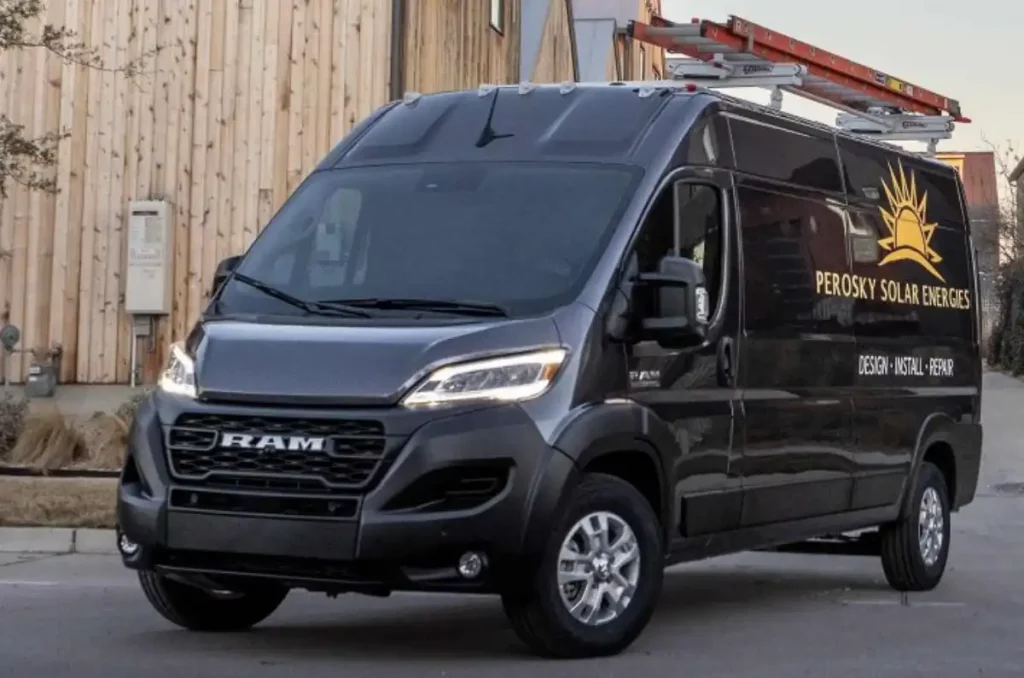
As well as knowing how much you can tow, you'll also need to know how to tow it. That's why you need to know where the tow hitch or towing eye is located on the Ram ProMaster.
The towing eye is screwed into the front of the cargo van to give a solid spot from which to tie a rope or chain. This then means that the van can be towed out if stuck.
The Ram ProMaster tow hook is located with the tyre jack which can usually be found under the front passenger seat.
The location for the eye to be screwed into the front bumper of the van is behind a small plastic cover to the side of the numberplate.
Simply pop the cover off and screw the Ram ProMaster towing hitch into the hole untill it is firmly secured.
Remember to remove the towing eye once you have finished towing. It is illegal to leave a towing eye in position as it is a protruding item from the front of the vehicle that could cause serious harm to other road users.
The two vans are pretty closely matched but the Mercedes Sprinter has a slightly larger towing capacity.
As you've already found out, the Ram ProMaster is capable of towing up to 6910 lbs whereas the Sprinter can tow 7716 lbs.
The Ford Transit can also tow a maximum of 7716 lbs, this is the best towing capacity for a light van.
The Ram ProMaster is produced by Stellantis, which is a combination of the Fiat-Chrysler brands and PSA Peugeot-Citroen.
The Ram ProMaster is made at the Saltillo van production site in Mexico in the Coahuila region. The area is home to a large amount of automotive production and produces commercial vehicles for Stellantis to export to the United States.
The Ford Transit Custom towing capacity is amongst the best in the medium van segment where the Transit Custom is the undeniable leader. Bought by UK van drivers in their thousands, the Transit Custom not only has a great ability to tow but is a comfortable, safe and economical van to be in.
The Ford Transit Custom towing capacity is up to 2.5-tonnes or 2,500kg. This is the total towing capacity for a Transit Custom with a braked trailer.
For an unbraked trailer is it also possible to tow up to 750kg with a Ford Transit Custom.
The Transit Custom towing capacity is what you would expect for a medium van and is an improvement over past versions which had a towing maximum of up to 2000kg. The improved 2,500kg towing capacity puts it at the top of the medium van segment along with rivals like the towing capacity of the Vauxhall Vivaro.
Each Ford Transit Custom van has the same towing capacity of 2.5-tonnes regardless of the model or engine power. Because there are 110hp, 136hp, 150hp or 170hp engines it’s important to consider that if you plan to tow a full trailer, or even a caravan, boat or car, using the Transit Custom it will be easier if you have the most powerful model.
Although simply saying that the Transit Custom can tow 2.5-tonnes makes it a nice and tidy answer, it’s not quite that simple.
Vans have a designated weight they are allowed to carry called the gross vehicle mass. This is the weight of the van (its kerb weight) plus the weight of any occupants or payloads.
There’s then the gross combination weight (GCW), also known as the gross train weight (GTW) which is the weight of the vehicle plus any load in the cargo area plus the weight of whatever you are towing.
The Ford Transit Custom towing limit is therefore the GCW which can be affected by the payload.
The Transit Custom has several permitted gross combination weights (GCW) ranging from 4,825kg to 5,725kg depending on the variants. A detailed breakdown of the GCWs is listed below which covers the engine size and gross vehicle weight (GVW) of the vans.
The GVW – which is the weight of the van plus the maximum payload – is limited to 3.2-tonnes, giving the Transit Custom a maximum GCW of 5,725kg. If you factor in the 3,225kg GVW you’ll see that 2.5-tonnes is the maximum possible towing weight for the trailer plus its payload. This means that even if fully loaded you won’t exceed the combined weights of the van plus trailer.
| Transit Custom GCW - Maximum (kg) | T280 | T300 | T320 |
|---|---|---|---|
| 2.0L TDCi Ford EcoBlue 110 PS (80 kW) | 4825 | 5025 | _ |
| 2.0L TDCi Ford EcoBlue 136 PS (100 kW) | 5325 | 5525 | 5725 |
| 2.0L TDCi Ford EcoBlue 136 PS (100 kW) 8-speed automatic | 5325 | 5525 | 5725 |
| 2.0L TDCi Ford EcoBlue 150 PS (110 kW) | _ | 5525 | 5725 |
| 2.0L TDCi Ford EcoBlue 170 PS (125 kW) 8-speed automatic | _ | 5525 | 5725 |
But you can see that if you have a Transit Custom 300 with a 110hp engine that allowance is drastically reduced. Here the 5025kg GCW and the 3025kg GVW of the Transit Custom means that there is just a 2-tonne towing capacity, if the van is fully laden.
Our advice is to consult the weight plates for the vehicle towing capacity and the Ford Transit Custom payload. These will usually be found inside the door frames – usually the passenger side – or under the bonnet.
The Transit Custom doesn't come with a tow bar as standard, but there is an option for it in the lengthy list of extras. A fixed tow bar can be specified for towing large items of up to 2.5 tonnes. The optional tow bar is designed to be fully compatible with the vehicle’s electrical system with a 13-pin connection to enable brake lights linked to the van to be shown on a trailer.
Prices for the tow bar and electrics are, at the time of writing, listed at £430 while a retractable tow bar for the Transit Custom is £550 (ex VAT).
The Ford Transit is the backbone of Britain for a reason, the Ford Transit towing capacity is unrivalled in the large van sector. The Ford Transit has the towing weight of a heavyweight boxer. It pulls no punches and the Ford Transit tow rating is as good as you'll find in the large van segment.
The Ford Transit van has a towing capacity of 3.5 tonnes or 3,500kg (7716 lbs) which is the weight a Transit can tow at its absolute maximum. This is the applicable to the all 3.5-tonne GVW models as well as some of the larger weight vans - the ones with double wheels.
The maximum Ford Transit towing weight is 3500kg for a braked trailer. The maximum unbraked trailer weight is 750kg. There are a few exceptions for smaller vehicles as to what size of braked trailer they are capable of pulling.
The Transit comes in smaller sizes with vans of a 2.9-, 3.1- and 3.3-tonnes. This poses a few problems for the overall towing capacity of the Transit because the GVW alters the gross train weight (GTW) - also known as gross combination weight (GCW) - of the van.
Ford makes it really nice and easy to figure out which van you've got. That's because you'll probably know that the large Transit vans are often referred to as Transit 350. The clue here is that the 350 part is in reference to its GVW of 3.5 tonnes.
The smaller models are therefore known as follows:
If you need to know about the Transit dimensions or the Transit payload we have handy guides which also explain these weights and sizes, but those are the basics you need to know about the Ford Transit weight for towing.
It sure can, a Transit van could tow a standard unbraked trailer as well as a proper braked trailer suitable for pulling a car.
You need to be mindful of what you put on the trailer that the Transit van is towing, but as it has such a high towing capacity of 3500kg most vehicles will be ok.
It does depend on the maximum weight of the car, boat, mobile home, jet ski or whatever else it is you fancy towing. The total payload on the trailer, plus the weight of the trailer itself, must not exceeded the Transit towing capacity. As most trailers are built to be light this shouldn't alter now much your Transit van can tow, but it's important to keep the overall total in mind for a couple of reasons.
Firstly, the weight of the trailer forms part of the towing allowance. The trailer weight is also part of the overall gross train weight (GTW) of the Transit van and trailer towing combination. Importantly includes the van, the people in the van and any other contents in the van - keep reading and you'll understand why this is a really crucial factor in the towing capacity.
The Ford Transit has a gross train weight of up to 7-tonnes or 7,000kg (15,432 lbs) for the very largest twin wheel vans. The other sub 3.5-tonne vans have a GTW of 5,000kg (11,023 lbs).
But what is GTW and why does it affect what I can tow? Well, the gross train weight is the total weight of the van plus the weight of anything you are towing, so imagine you've filled a 3.5-tonne Transit van completely full of weight but then you need to tow something.
The total of the Transit, plus fuel, plus your weight, any passengers and whatever you have in the cargo area has an overall weight of 3500kg. In order to not exceed the total allowable GTW of 5500kg you must therefore not tow anything more than 2000kg.
If you want to maximise your towing capacity and tow a full 3500kg - the maximum the Transit is safely allowed to tow, so as not to damage the chassis or towing arm - then you'll have to lower the amount of weight you are carrying.
The Ford Transit tow bar isn't a standard fit item but it can be specified as an option on all models. The tow bar for the Transit costs just £400 as an option and depending on the spec of the vehicle you have gone for (ie. which trim it is, Limited, Trend etc) it will also then come with Trailer Sway Control. This is a safety feature designed to stop the trailer from snaking around when it becomes unstable.
Despite the size of a Ford Transit it is still possible to tow it. The Ford Transit has a dedicated towing eye with the mounting point. The Transit towing eye location is in the front of the grille.
First you need to get the towing eye which can be found under the passenger seat of the Transit - it's usually bolted to the floor.
You then need to connect the towing eye to the front of the van. The location to put the towing eye on the Transit is behind a small circular cover to the side of the numberplate and next to the headlight.

You'll need to push the circle in and use a plastic device (so as not to scratch the paint) to prize the cover out. Simply insert the Transit's towing eye into the recessed hole and screw it into place. You can now insert a towing rope into the hole.
As well as using and above towing eye for the front of the vehicle there is also a towing eye loop at the rear of the Transit. It's a small loop under the rear bumper that you can see if you duck down a little bit behind the van.
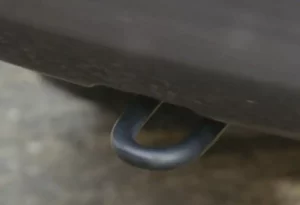
You can use it for winching the Transit van if it gets stuck so it will help with recovery. It's not to be used for towing in the same way as the dedicated towing eye mentioned above.
The Vauxhall Vivaro has a towing capacity of up to 2.5-tonnes or 2,500kg. That is the total towing capacity for a braked trailer on the latest van.
It is also possible to tow an unbraked trailer of up to 750kg using a Vauxhall Vivaro.
The Vivaro towing capacity is above average for a mid-sized van. Previous versions were only capable of towing up to 2000kg, but the newest model can pull an improved 2,500kg. That makes the towing capacity of the Vauxhall Vivaro better than some of the competition, however, it is still well below the maximum that you will find on large vans like the towing capacity of a Sprinter van, or even a pick-up truck.
Whether or not it is any good for towing will also depend on which model you decide to buy. All Vivaro vans have the same towing capacity of 2.5-tonnes, irrespective of which engine they have. With 125hp and 145hp variants to choose from if you plan to tow a full trailer using the Vivaro it would be best to go for the more powerful model.
It’s not as straight-forward as saying that the Vivaro can simply tow 2.5-tonnes and that’s the end of the matter. There’s also the vehicles entire weight to consider, or the gross combination weight (GCW) or gross train weight (GTW). This is the weight of the vehicle, plus any load in the cargo area, plus the weight of whatever you are towing. This is what makes up the entire Vauxhall Vivaro towing limit, in other words its Van + Payload + Trailer.
Fortunately, this is more simple than in most vans, as the all but the double cab variants have a gross combination weight (GCW) of 5.6-tonnes or 5600kg.
Given that the gross vehicle weight (GVW) which is the weight of the van plus the maximum payload is limited to 3.1-tonnes for the very largest models, adding on the 2.5-tonnes possible for the weight of the trailer plus its payload means that you won’t fall foul of exceeding the combined weights of the van and trailer, even if you ware fully laden.
There is a slight snag. If you have the 1.5-litre engine, it gets a slightly lower gross vehicle weight of 2830kg. That means that you’ll have to be slightly more cautious with the amount of payload you put in the back of the van.
As always, our advice is to check the towing capacity and the Vauxhall Vivaro payload capacity on the plates for the vehicle. These can often be found either inside the door frames – usually the passenger side – or under the bonnet.
Vauxhall Vivaros do not come with a towbar as standard, but they can be added as a factory spec item. The ball and hook tow bar option on the Vivaro is an option for all vans and adds a 13-pin connector plug for the wiring up of a towing bar. At the time of writing it costs around £700 for the Vivaro towbar.
If you want to know how to tow a Vivaro you’ll need to find the towing eye. The towing eye location is found under the front bumper, off the side of the main chassis arm. You’ll have to get under the front of the van in order to find the towing eye, and you will also need to be considerate of the bumper itself when towing.
The Mercedes-Benz Sprinter is the largest van in the Mercedes range and have a towing capacity to match. In fact, the Sprinter is so good at towing that it can tow an elephant - pictures don't lie.
The majority of Mercedes Sprinter vans have a towing capacity of 3.5-tonnes or 3,500kg (7716 lbs). This is how much weight a Sprinter can tow as a maximum and is applicable for the 3.5-tonne GVW models and larger 5- and 5.5-tonne vans. Smaller vans with a GVW of only 2.8-tonnes can tow just 2-tonnes or 2,000kg (4400 lbs).
The easiest way to check your towing capacity is to look at the vehicle plating weights on the door frame of the van, or under the bonnet. These will tell you exactly what the Sprinter van can tow as well as giving the GVW and the Sprinter payload.
However, the badges on the back of the Sprinter give you a clue as to its size. Mercedes produce models with numbers like the Sprinter 215, 315, 317, 319 and 515, 517 and 519 which denote the gross weights of the vans. The 2xx-series are capable of towing the smaller 2-tonne capacity, while the 3xx-series and 5xx-series can tow the higher weights of up to 3.5-tonnes.
Yes, a Sprinter van could tow a car but it all depends on the maximum weight of the car which will determine if you have exceeded the Sprinter towing capacity. As most cars are under 3.5-tonnes, the majority of cars can be towed by a Sprinter van, but you must also factor in the weight of the trailer (assuming you are using one) and consider the overall gross train weight (GTW) of the van and car combination.
The Mercedes-Benz Sprinter has a gross train weight of up to 7-tonnes or 7,000kg (15,432 lbs). That's for the very largest vans in the 5-series of weight category. The more standard 3.5-tonne vans have a GTW of 5,000kg (11,023 lbs).
So, what is GTW and why does it affect what I can tow?
Well the gross train weight is the total weight of the van plus the weight of anything you are towing.
For example, the easiest way to understand this is to imagine you've filled a 3.5-tonne Sprinter van completely full of weight. The total of the Sprinter, plus fuel, plus your weight, any passengers and whatever you have in the cargo area has an overall weight of 3500kg. In order to not exceed the total allowable GTW of 5500kg you must therefore not tow anything more than 2000kg.
If you want to maximise your towing capacity and tow a full 3500kg - the maximum the Sprinter is safely allowed to tow, so as not to damge the chassis or towing arm - then you'll have to lower the amount of weight you are carrying. To figure out the maximum you can carry it is therefore: Gross Train Weight minus kerbweight = maximum towing capacity.
The tables below will help explain the towing weights for the Euro 6 and Euro VI versions of the Sprinter.
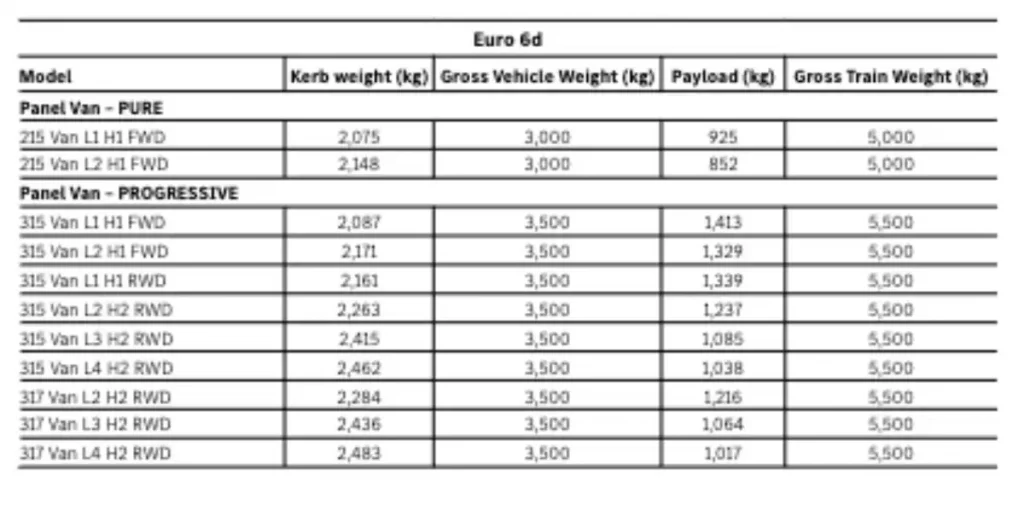
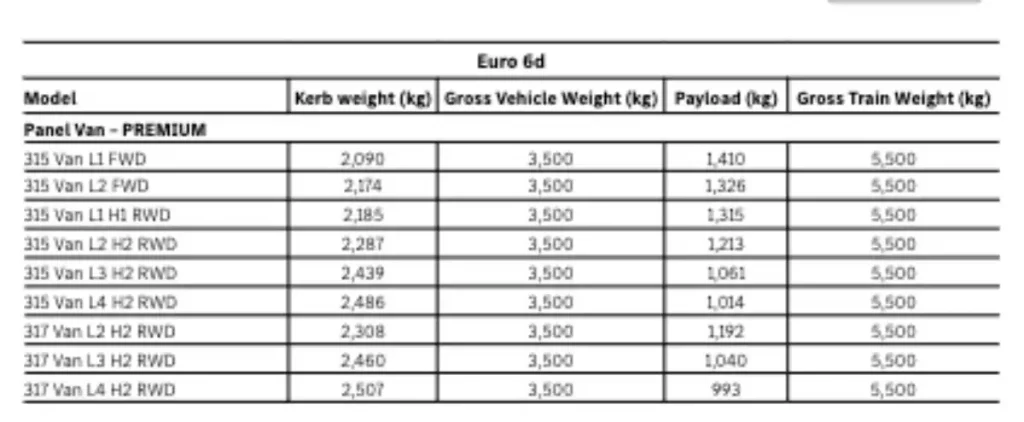
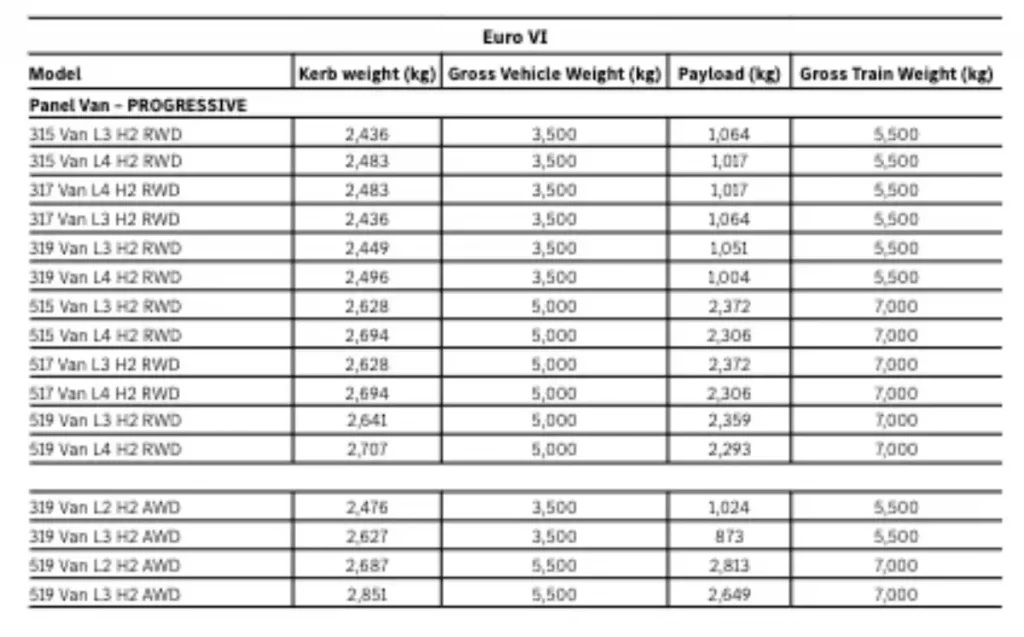
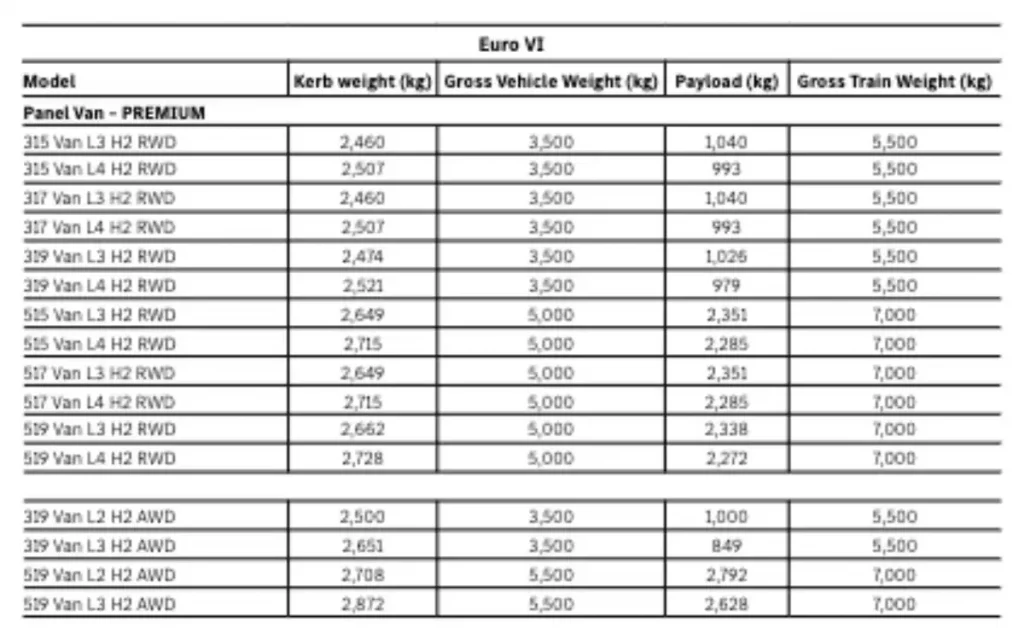
The only Sprinter models capable of carrying the complete 3.5-tonnes are the Sprinter 515, Sprinter 517 and Sprinter 519. Their 7-tonne GTW minus kerbweight of roughly 2.7-tonne (depending on version) is comfortable enough to tow a full weight trailer combination with some payload in the cargo space.
The best of the other models is the Sprinter 315 which can roughly tow 3,400kg. However, that is a front-wheel-drive (FWD) model which may not be most suitable for towing heavy loads. A rear-wheel-drive (RWD) variant would be more suitable and for that you'll need a Sprinter 315 RWD which can tow a maximum of 3,339kg.
No, the Sprinter doesn't come with a tow bar fitted as standard but it is easy enough to specify one from the options list. There are even a couple of Sprinter tow bar types to choose from with a fixed coupling head (c. £650) and a removable trailer coupling ball (£900). You can then decide if the tow bar for the Sprinter needs a trailer socket for a 13-pin electrical system (£300) and there are various enhanced towing capacity options depending on what GVW van you have.
The Sprinter towing eye can be found in the toolkit of the van which is normally located in a drop down panel in the door of the van. In there you'll find the towing eye which needs to be put into the front bumper in order to tow a Sprinter. There's a small square-shaped panel in the lower portion of the front bumper to the side of the numberplate. Pop this cover off using something like a flat head screw driver and simply screw the towing eye into the Sprinter.
When it comes to towing and determining what is the best van for towing it’s crucial to consider several factors as there are so many models and variations available. It can be difficult to know which one is the best fit for your needs.
In this article, we’ll take a look at some of the key factors to consider when selecting a van for towing, and recommend some of the best models currently on the market.
One of the most important factors to consider when selecting a van for towing is weight capacity. The weight capacity is the maximum amount of weight that the van can safely tow, including the weight of the trailer and any cargo inside. Exceeding the weight capacity can result in dangerous overloading. This can lead to a loss of control, reduced braking ability, and damage to your vehicle.
Before selecting a van for towing, it’s important to determine how much weight you’ll need to tow. This will depend on the size and weight of the trailer, as well as any cargo that will be transported. Once you have an estimate of the total weight, you can look for vans with a weight capacity that exceeds this amount. Pick-up trucks also have the ability to tow. Most pick-up trucks can tow more than 3 tonnes, and many can tow the maximum 3.5-tonnes.
In addition to weight capacity, power and performance are also important factors to consider when selecting the best van for towing. Vans with larger engines and higher horsepower will generally be better suited for towing heavy loads. Similarly, vans with all-wheel drive or four-wheel drive may provide better traction and handling on rough or slippery terrain.
When evaluating vans for towing, it’s important to look at factors such as horsepower, torque, and towing capacity. These specifications will give you a good idea of the van’s overall power and performance capabilities, and help you determine whether it’s a good fit for your towing needs.
Towing can be a dangerous activity, particularly if the trailer is large or heavy. To minimise the risk of accidents or injuries, it’s important to select a van with strong safety features. Some important safety features to look for when selecting a van for towing include:
You'll need to ensure that your vehicle is equipped with a tow bar, which typically includes a ball mount and clip. Additionally, you'll need to have a wiring harness to ensure the towed unit's electrical system, including the brake lights, is functioning properly. It is also essential to have a spare number plate for the vehicle you're towing with to display on the trailer.
It's worth noting that large vans generally have a towing capacity exceeding 3000kg, allowing them to tow a wide range of trailers, however, even among different versions of the same van model, the towing capacity can vary significantly. Check the plated weights of the vehicle – these can usually be found inside the door frame of the van.
Finally, it's crucial to take into account the van's gross train weight (GTW) or gross combination weight (GCW). This weight represents the maximum combined amount the kerbweight of the van, its load, and the trailer can be. For example, if your 3.5-tonne van can tow up to 3000kg, you'll need a GTW of 6.5 tonnes to use both the van and the trailer fully loaded. If the GTW is lower, you'll need to adjust the payload of either one or both accordingly.
With these factors in mind, let’s take a look at some of the best vans currently on the market for towing.
Our extensive guides on the towing capacity of individual models can be found in the towing section of the website.
There you will find individual articles on the towing capacity of models from small to large including the following: